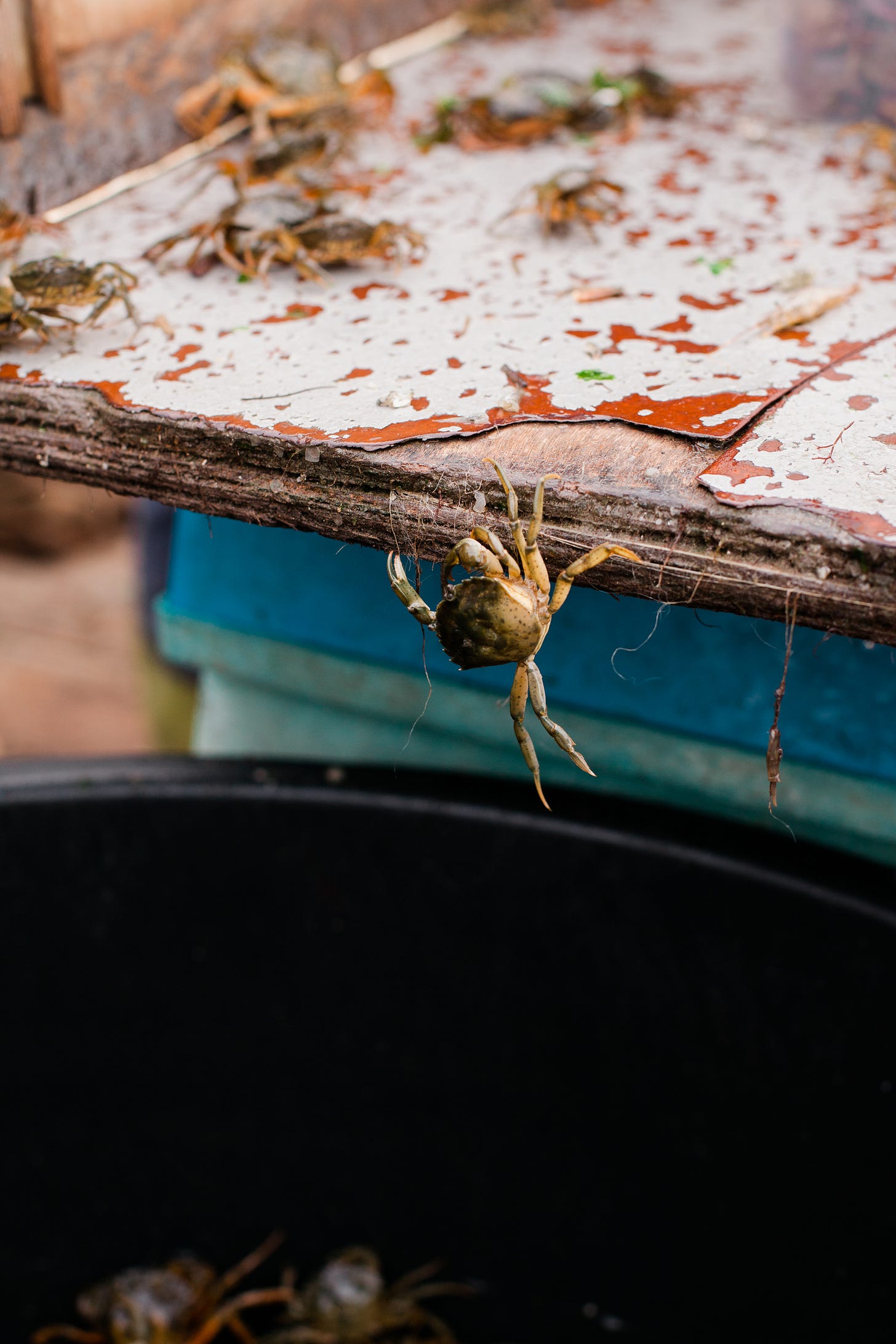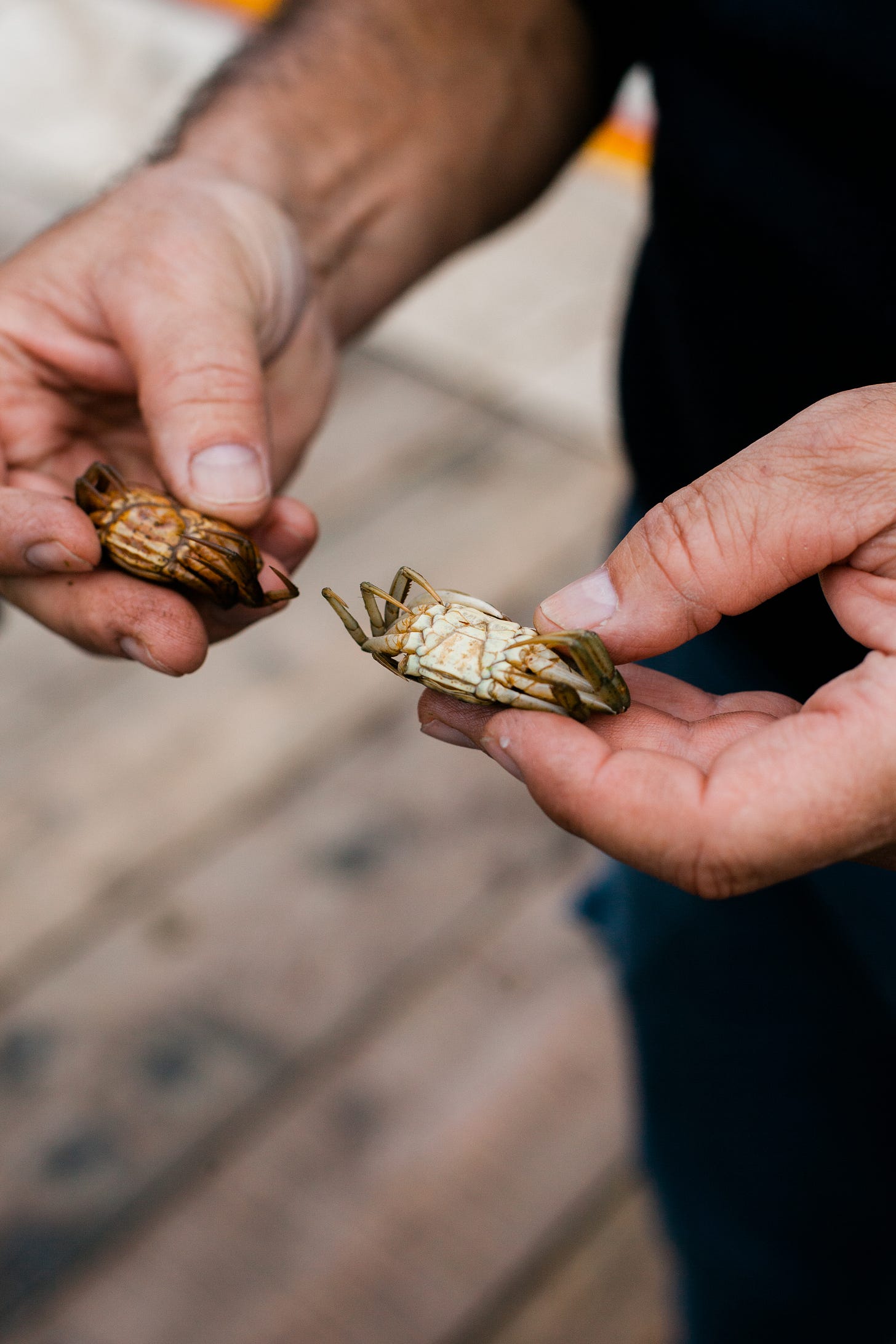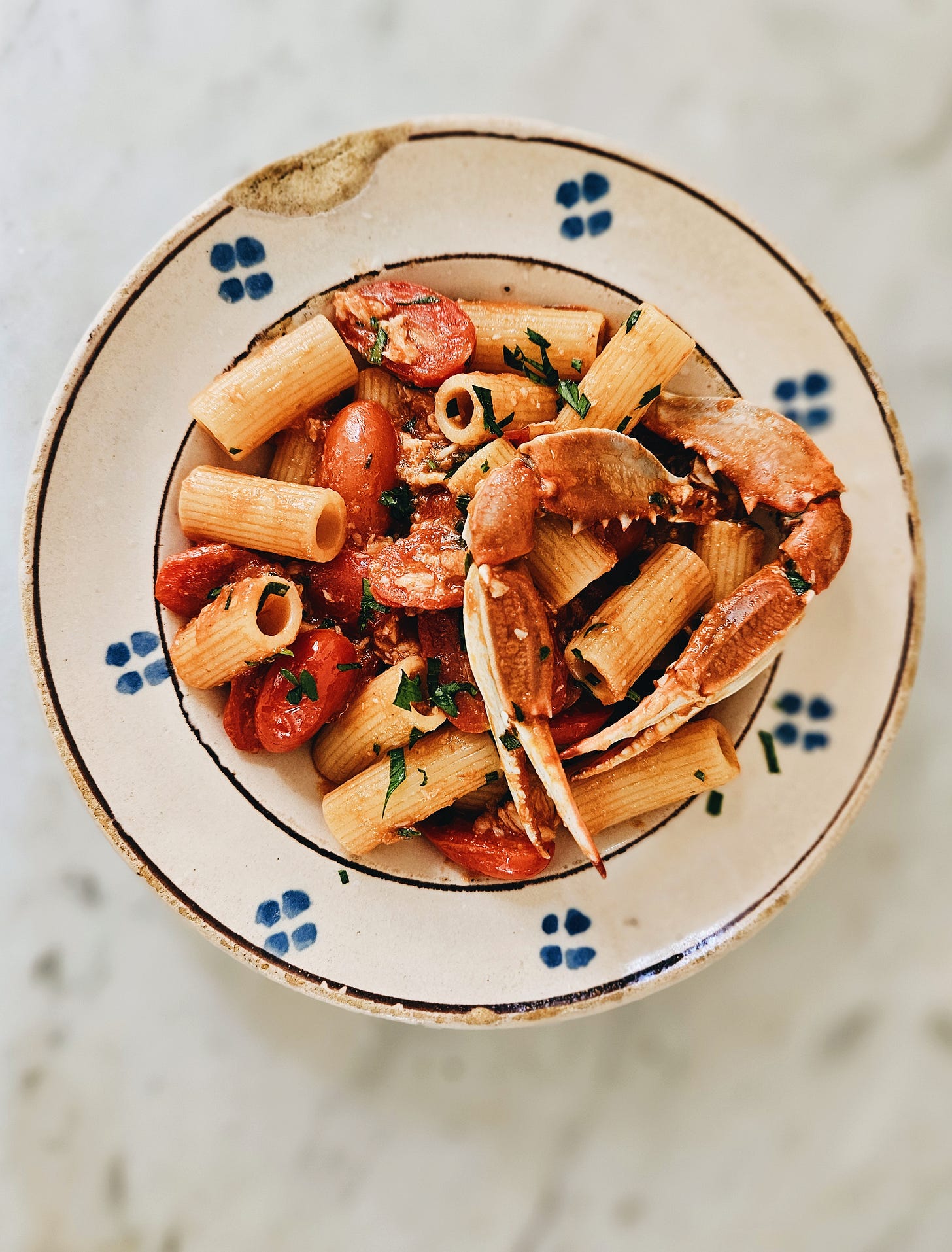Blue crab rigatoni with colatura di alici
Can we save Venice by eating our way through the blue crabs?
Blue crab is a delicacy in many parts of the world, but a mention of the “granchi blu” to an Italian fisherman will make them shudder. This aggressive, predatory crab originating from the Americas (Chesapeake blue crab, Maryland blue crab or Callinectes sapidus) has become an invasive species in Italian seas and precious ecosystems like the Venetian lagoon are being completely ravaged by them. Their natural predators (such as sharks and sting rays) don’t exist in these places and the crabs are reproducing without limits, destroying stocks of other precious seafood in the ecosystem such as clams, oysters, mussels, shrimp and smaller crabs like the Venetian moeche, tiny green Mediterranean crabs.
A little over a year ago, the Guardian published this piece, bringing some of the situation to light for English readers. The blue crab, which reached Italian seas likely through the ballast water of cargo and cruise ships, not only poses a threat to the environment but also to the thousands of businesses that survive on fishing as their livelihood, and to regional Italian food culture as a whole. Here I’m going to mainly talk about crabs in Venice but this is deeply affecting everywhere from shellfish stocks on the coast of Emilia Romagna (in Comacchio they have had to stop farming shellfish altogether) to the Po River, where the crabs have been found even 50km from the sea up the river (!) to the lagoon of Orbetello in southern Tuscany, a haven for eels.
Back in May when I was in the Venetian lagoon, I saw it with my own eyes — the blue crab situation has escalated dramatically in even a year. This photo below of the tiny green moeche was taken in 2020, when the blue crab situation was still little known.
The Barena Association, which is based in Burano (the rainbow coloured fishing island and beloved home of my lagoon workshop), is named for the barene, the salt marshes of the lagoon, that recently posted some numbers that blew me away:
📍The number of blue crabs in kilograms sold by Burano fishermen in:
2022: 223 kg
2023: 40,839 kg
2024 (the first four months only): 40,880 kg
The sharp rise in blue crab is exponential.
📍What a fisherman takes home
circa € 100/kg for moecca (Mediterranean green grab, which are being annihilated on a large scale by the blue crab)
€ 1.50/kg for blue crab.
This year, there is even a recorded sale of € .5 cents/kg.
Imagine a 99% drop in your income. Fishing and exporting blue crab is expensive, complicated and requires processing infrastructure and export possibilities that are, unfortunately, limited at this time. None of the promised federal support has arrived to date.
📍We ask what our role can be, how can we help and support this situation?
In addition to the SOS Barena project, Barena Association seeks to communicate the realities of the situation to anyone who will listen. Are you an entrepreneur with international connections? We can share some ideas with you and put you in touch with relevant people.
One obvious answer is that we need to act as the predator of the blue crabs and eat them ourselves — Chiara Pavan, chef of Venissa’s Michelin starred restaurant on Mazzorbo island in the Venetian lagoon, has long been championing this concept, preferring to put invasive species like blue crab on her menu for the past several years, rather than the local delicacy, moeche, which are getting harder and harder to find (I have had her chilli crab pasta, it is divine; but she makes many other dishes with it, like this Japanese inspired chawanmushi, above).
Here in Italy, blue crabs are being practically given away — here is a photo I took at the supermarket this week. They cost 8,90 euro per kilogram at my local supermarket. Two blue crabs cost me less than 2 euro! I don’t think there are many cheaper types of seafood or meat right now. But is it enough to just eat our way through them? I would love to know if Italians actually embracing and eating the blue crabs too — from what I hear from Venetians they are not really eating them, they’re considered no where near as good as the moeche — although chefs like Pavan are trying to change people’s minds.
I spoke with Venice-based Allison Zurfluh, one of the key members of the Barena Association, an artist and conservationist who is passionate about Burano and the Venetian lagoon ecosystem. I asked her what can we do, what can we really do to help this situation in Venice and it was enlightening.
“There’s almost no moeche left. Domenico said there are only blue crabs,” she said, mentioning one her close friends, Domenico Rossi and Burano’s best known moeche fisherman (read, in Italian, more about him here on Corriere, where this photo below is from).
“Just eating them is not enough,” Allison maintains, “You need mass fishing and to produce something out of them in a big factory. The fisherman know this but they don’t have the connections or a way to process and transport [the crabs]. You need an entrepreneur who knows how to do this.”
It reminded me of a long conversation I had had recently with my friend, Josh Shuffman, sourdough baker extraordinaire and native of Baltimore who lives in Florence. “Nobody really knows how to cook them properly here… This is a luxury food in the US that commands a high price,” he wrote to me. It was enough for me to pick up the phone and get into a long chat with him about how to make and eat Maryland steamed crabs and hear about the luxury that is blue crab meat, already picked from the crab and canned, which can easily cost $150 per kilogram.
Surely there is a missed business opportunity here for someone — and a way to get rid of or at least tame the number of these crabs.
Back on the phone with Allison, we talked about the way of life on the colourful old fishing island of Burano that is quickly disappearing (this photo I took of the lone man sitting with the piegons is what was once the fish market of Burano; you can now no longer buy fish on this island of fishermen), the importance of protecting the barene, the salt marshes, which are the home of the Venetian moeche crabs (these little green crabs do not swim like their blue counterparts, they need to cling to something to get around). We spoke about the fishermen pulling up nets blocked with jellyfish and blue crabs, tens of thousands of them.
I felt almost silly cooking up only a few blue crabs when there needs to be a bigger solution to get rid of thousands of them at a time.
I wondered if there is anything that the millions of visitors to Venice could be doing to help — perhaps not ordering moeche, if there are even any left? Ordering blue crabs instead? Obviously not arriving in cruise ships that only bring more invasive species? Allison had some ideas and a solid suggestion.
“Don’t rent a boat,” She said. “Self renting boats are a terrible idea. Don’t go into the northern part of the lagoon. People are going into places that are hurting the environment. They don’t have licences, they flatten the mud flat with their boats and the erosion process begins. They break rules and they have left an indelible mark."
What to do instead: “Go with a Bragozzo,” — a Bragozzo is a traditional Venetian fishing boat — “These are people who live here and they want to show people this way of life. In a Bragozzo, they can talk, see the work they are doing in terms of fishing.”
Many moecanti (the crab fishermen) are no longer making a living with their traditional work and so for example, Manuel Bognolo from the Giudecca (his hands are below, holding two moeche, a photo I took in 2020 when these crabs were still around) has transformed his family’s old crab fishing boat into a pretty sophisticated kitchen operation, so he can take you out to the southern lagoon and cook for you. Domenico Rossi from the Barena Association in Burano takes people on visits to explore the precious barene and do hands on fishing experiences through his Pesca Turismo Nettuno company.
A blue crab recipe
Until someone comes along with the connections and who understands how to get rid of mass quantities of blue crabs, we can still do our bit by buying, cooking and eating blue crabs. If you’ve ever wondered what to do with them, crabs make a perfect pasta sauce and are really quick to cook, the only fiddly bit is pulling the meat out of the shell. Here in Italy, blue crabs are sold with the top shell already moved and so it is pretty easy to handle. This was a perfect — and very cheap — lunch for two but why not multiply it and throw your friends and family a big crab party?
If you want to elevate your pasta sauce, may I introduce you to a secret ingredient that is colatura di alici? It is like an Italian fish sauce — an ancient condiment from Cetara on the Amalfi coast that was collected from the drippings of salted anchovies. It adds the most incredible flavour — not fishy, or strong, just pure flavour. It enhances the natural flavours of the dish like any intensely umami ingredient does (think parmesan, dried mushrooms or Japanese dashi). Get your hands on some if you can afford to splash out (these little bottles are not that cheap, but just know that a few drops go a very long way!). If you don’t have it, just leave out or perhaps add an anchovy (this is surprisingly an entirely different flavour to colatura but a good one).
Blue Crab Rigatoni with Colatura di Alici
For 2
4-6 blue crabs, cut in half
2 glugs of extra virgin olive oil
1 clove garlic, peeled but whole
About 10 cherry tomatoes, halved
250 ml passata
Parsley
1 dried chilli (or as much as you like)
Splash of colatura di alici
160 grams dried rigatoni (or other favourite pasta shape, spaghetti or paccheri would be great too)
To make the sauce, heat the oil in a pan with the garlic clove and let the oil infuse but take care that the garlic doesn’t burn. As these crabs are sold already with their armour of a shell removed, you can just chop them in half and toss them in the pan. Let them “toast” a bit on either side for a few minutes total, then add the cherry tomatoes, along with a good pinch of salt, the passata and a splash of colatura. I like to add a splash of water or white wine with my passata too and the stalks of the parsley, which, if you leave them long, are really easy to remove later.
Let all this bubble together for about 5-7 minutes. Blue crabs are like those colour changing toys — they let you know when they are cooked by turning from bright blue to bright orange. At this point, turn the heat off, remove the crab halves to a chopping board and when cool enough to handle, you can pick* out the crab meat from inside the shells and add this back to the sauce. Chop off the big meaty claws and add these back to the pan too — they serve as decoration but I like a bit of interactive dining too and these can be opened* and chewed on while you’re having your pasta. All that is left to do now is boil the pasta and when al dente, drain it and toss into the sauce, heating it briefly together with a splash of the pasta water and then serve with the claws on top and a sprinkle of finely chopped parsley leaves.
*Yes, there’s the fact that there is tomato sauce and your hands will get tomato-y and some people (aka my husband) are not into that. If this is a problem for you, I suggest right at the beginning, when toasting the crabs in the garlicky olive oil, wait for them to turn orange and pick out the meat then. But my feeling is that cooking the whole crabs in the tomato sauce will give you more flavour and personally I am not worried about a tiny bit of tomato on my finger tips in exchange for flavour.
Thank you to Allison and the Barena Association for taking time out to talk to me about the situation in Venice right now and to Josh Shuffman for always keeping me up to date on what to do with blue crabs!












I'll try to do my part to eat some blue crabs when I am there in late December!
Blue crab is truly a delicacy in the eastern United States. I love that you are looking at different ways to prepare them so that they suit Italian tastes as well. There’s got to be someone out there with the will and the money to find a solution to the problem. 🤞🏻